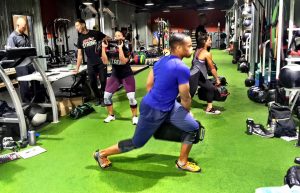Making Lunges A True Powerhouse!
2018-11-14
If people had to ask me for the best piece of advice to having success, I would say it is making more time for the things you aren’t great at! I know, that isn’t a Josh original statement, but it is true! The perfect example of that is the power and emphasis we place on lunge. You know in DVRT lunges play a HUGE role and not because I am not especially exceptional at them. So, why are lunges so important to what we do in DVRT?

Looking at the 7 primal movement patterns, a lot of people like to overlook lunges. They aren’t especially “sexy” when it comes to the loads most people can use. You are unlikely to hear about 500 pound lunge PRs or going #beastmode on lunges. However, if we look at the benefits of lunges it is hard to deny their power!

-Lower leg/foot/hip stability and strength
-Multi-planar training, especially resisting the frontal plane
-Acceleration and deceleration training which is huge for building injury resiliency
-Training the glutes and core in the tri-planar nature that these muscles are designed to function
Okay, lunges are awesome, but the problem is that people either have pain or an inability to progress lunges the best ways possible. A LOT of the knee issues can be helped by just getting people to learn to drive into the ground with their feet! That helps stabilize the knee and engages the core and glutes before we even start moving!
https://www.instagram.com/p/BnBdxhOFo93/
Using the half kneeing position with these specific tension techniques allows us to build a foundation to lunges that helps transfer in learning how to create stability while we are unstable!
Building lunges are also hard for many, that is why we can use so many layers that allow us to build strength, stability, and mobility at the same time. DVRT Master, Cory Cripe, shows one of our favorite ways which is to combine Up Downs with Front Load position with our Core Strap and band. Why?
https://www.instagram.com/p/Bp2FBviBfAl/
Creating tension and trying to break apart the Ultimate Sandbag with the band tension really engages the lats and core. This brings to life the idea that spinal stability allows us through better use of the hips. Most people start with no resistance and this is actually a mistake because people not only lack any feedback during their lunges, but also don’t get that specific core engagement that allows for better movement.
You might think that we just move to great lunges like MAX lunges, but the reality is there are many layers we can create based upon continuing the idea that Cory shows. DVRT Master, Ara Keshishian, breaks down some easy ways we can use the DVRT concept of changing load position to make an exercise more difficult or easier.
https://www.instagram.com/p/BpZP_kJhyEK/
These progression of lunges are typically fantastic by themselves, but when we think BIGGER we realize that our movement needs to progress not just heavier, but being more reactive. What do I mean by reactive strength training? Great athletes know this all too well as leading spine expert, Dr. Stuart McGill explains…
“When muscle contracts both force and stiffness is created. Force is needed to initiate and propel motion but stiffness slows the motion. How is great speed produced? Measuring the muscle activation profiles in elite MMA athletes revealed a “double pulse” where a pule initiates motion, a relaxation phase occurs as the foot or fist increases closing velocity to the target, then a second pulse creates a final stiffening upon impact to enhance “effective mass” and transference of force to the target (McGill, Chaimberg, Frost and Fenwick, 2010). Elite performance was not defined by strength but by rate of muscle activation and relaxation. Relaxation rates were measured in this elite population to be up to 6 times faster than a control group of Graduate students (Hubrecht, Marshall and McGill, submitted).
World champion golfers exhibited similar pulse relaxation cycles. The downswing was initiated with a modest pulse of torso/hip muscle. Just before ball/club impact the rear leg gluteal muscles pulsed, while the torso musculature pulsed upon ball impact, only to be followed with a rapid relaxation to facilitate a fast follow-through of the club (McGill, 2009). Again, club speed was optimized not with muscle force but with impressive rate of relaxation to allow speed with effective mass being accomplished with a mid-swing pulse at ball contact.
An Olympic sprinter showed the same ability to pulse sequence muscle to propel a stiffened torso (McGill, 2009).”
How does that apply to lunges? We can do this progressively as well which is what DVRT is all about. Below I demonstrate some great ways to build foundations in these reactive lunges that really integrate the entire body at once!
That is the key in developing real world strength. You have to know how we move in the real world! We want to make this information as accessible as possible, that is why we are offering our DVRT training tools and online education 30% with coupon code “thanks” HERE
https://www.instagram.com/p/Bp66bnYhcK4/
© 2025 Ultimate Sandbag Training. Site by Jennifer Web Design.







